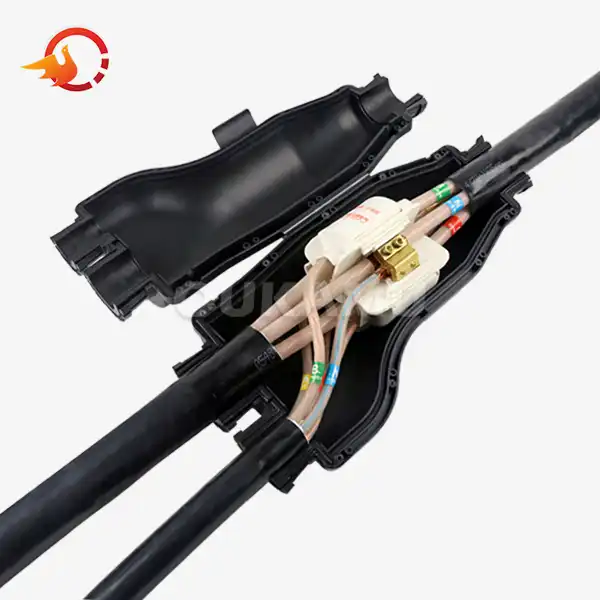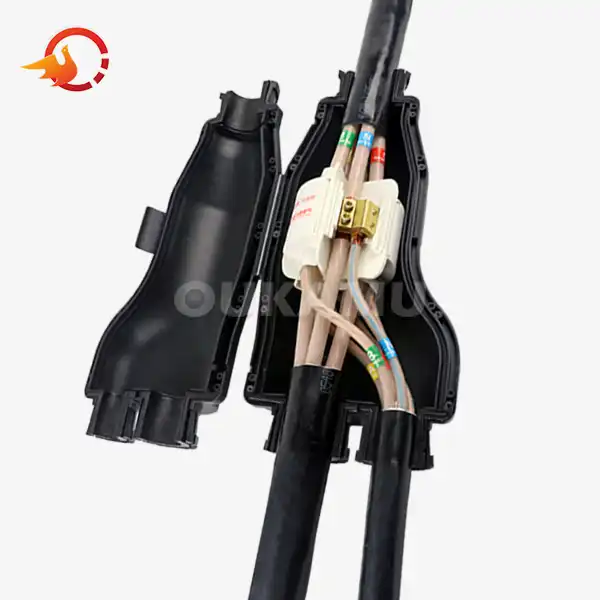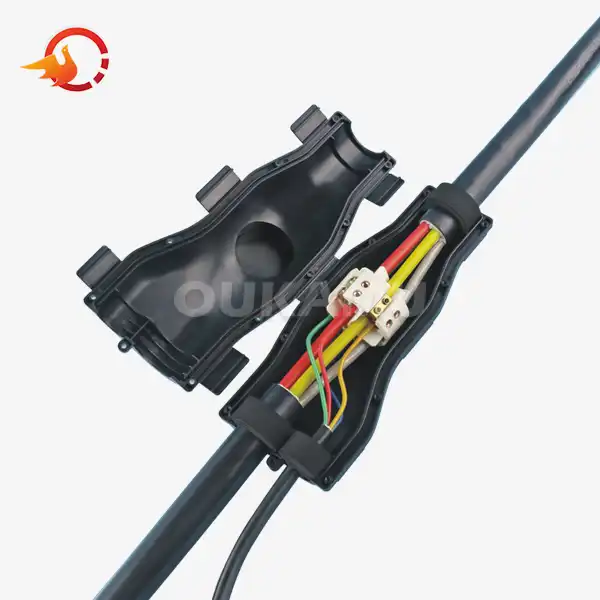The Importance of Quality Power Cable Joints in Electrical Work
 2025-07-16 07:17:08
View:389
2025-07-16 07:17:08
View:389In the realm of electrical engineering and power distribution, the significance of high-quality power cable joints cannot be overstated. These crucial components play a pivotal role in ensuring the seamless flow of electricity, maintaining system integrity, and safeguarding against potential hazards. As we delve into the world of power cable joints, we'll explore their critical functions, the benefits of using premium products, and the impact they have on overall electrical system performance.
Understanding Power Cable Joints
Power cable joints, often overlooked by the casual observer, are the linchpins that hold our electrical infrastructure together. These specialized components serve as the vital links between cable sections, allowing for the extension of power lines and the creation of branch circuits. Without reliable cable joints, the distribution of electricity would be fraught with inefficiencies and safety risks.
The Anatomy of a Quality Power Cable Joint
A well-designed power cable joint comprises several key elements that work in harmony to ensure optimal performance:
- Insulation: High-grade insulating materials prevent current leakage and protect against environmental factors.
- Conductors: Precision-engineered connectors facilitate the smooth transfer of electricity between cable sections.
- Shielding: Electromagnetic shielding minimizes interference and enhances signal integrity.
- Waterproofing: Robust sealing mechanisms guard against moisture ingress, a common culprit in electrical failures.
- Strain Relief: Thoughtful design elements mitigate mechanical stress on the joint, prolonging its operational life.
The Evolution of Cable Joint Technology
The field of cable jointing has witnessed remarkable advancements over the years. From the rudimentary tape-wrapped joints of yesteryear to today's sophisticated integrated T-connectors, the industry has continuously pushed the boundaries of what's possible. Modern cable joints, such as those pioneered by Xi'an OUKAMU, incorporate cutting-edge materials and innovative designs that address the complex demands of contemporary electrical systems.
These technological leaps have resulted in joints that are not only more reliable but also easier to install and maintain. The introduction of features like flame retardancy, fire resistance, and mineral insulation has expanded the application scope of cable joints, making them suitable for even the most demanding environments.
The Critical Role of Cable Joints in Electrical System Integrity
The importance of quality power cable joints extends far beyond their basic function of connecting cables. These components are integral to maintaining the overall health and efficiency of electrical systems across various sectors.
Ensuring Uninterrupted Power Flow
In industries where continuous operation is paramount, such as healthcare facilities or data centers, the reliability of power cable joints can make the difference between smooth operations and costly downtime. High-quality joints minimize the risk of electrical faults, ensuring a steady and uninterrupted flow of power to critical equipment.
Enhancing Safety in Hazardous Environments
Certain work environments, such as oil rigs or chemical plants, present unique challenges for electrical systems. In these settings, cable joints must not only conduct electricity efficiently but also withstand extreme conditions and potential exposure to corrosive substances. Premium cable joints with advanced insulation and sealing properties significantly reduce the risk of electrical accidents in these high-stakes environments.
Supporting Sustainable Energy Initiatives
As the world shifts towards renewable energy sources, the demands on electrical infrastructure are evolving. Solar farms and wind turbines require robust cable joints capable of handling variable loads and withstanding outdoor conditions. Quality joints play a crucial role in minimizing energy loss and maximizing the efficiency of these sustainable power generation systems.
The Long-Term Benefits of Investing in Premium Cable Joints
While the initial cost of high-quality power cable joints may be higher than that of their lower-grade counterparts, the long-term benefits far outweigh the upfront investment.
Reduced Maintenance and Replacement Costs
Premium cable joints, such as those offered by industry leaders like Xi'an OUKAMU, are engineered for durability and longevity. Their superior construction and materials resist degradation, reducing the frequency of maintenance interventions and replacements. This translates to significant cost savings over the lifespan of the electrical system.
Improved Energy Efficiency
High-quality cable joints minimize electrical resistance at connection points, reducing energy loss through heat dissipation. This improved efficiency not only lowers operational costs but also contributes to a reduced carbon footprint, aligning with global sustainability goals.
Enhanced System Reliability and Performance
By investing in top-tier cable joints, electrical engineers and system designers can drastically reduce the likelihood of system failures and downtime. This reliability is crucial in mission-critical applications where even brief interruptions can have severe consequences.
Flexibility in System Design and Installation
Advanced cable joints, particularly those with features like the ability to make connections without cutting the main cable, offer unprecedented flexibility in system design and installation. This adaptability can lead to more efficient use of materials, reduced labor costs, and faster project completion times.
The innovative integrated T-connector developed by Xi'an OUKAMU exemplifies this flexibility. Its design allows for branch connections at any point along the main cable, eliminating the need for pre-determined branch locations and reducing waste. This level of adaptability is invaluable in complex installations or projects where changes may occur during implementation.
Compliance with Evolving Industry Standards
As electrical safety standards and regulations continue to evolve, investing in high-quality cable joints ensures ongoing compliance. Premium products are often developed with future requirements in mind, providing a measure of future-proofing for electrical systems.
For instance, the cable joints produced by Xi'an OUKAMU comply with international safety standards and the GB/T 14048.7-2016 specification, demonstrating a commitment to meeting and exceeding industry requirements.
Streamlined Installation Processes
Modern, high-quality cable joints are often designed with ease of installation in mind. Features such as tool-free assembly, clear installation instructions, and pre-packaged components can significantly reduce installation time and the potential for errors. This not only saves on labor costs but also minimizes the risk of improper installation, which can lead to premature failures or safety hazards.
Adaptability to Technological Advancements
As power distribution systems become more complex and integrate with smart grid technologies, the role of cable joints becomes increasingly sophisticated. Premium joints are often designed with future compatibility in mind, potentially supporting features such as integrated sensors for real-time monitoring or compatibility with emerging power management systems.
Risk Mitigation and Liability Reduction
In the event of electrical failures or accidents, the use of high-quality, standards-compliant cable joints can provide a measure of legal protection. Demonstrating the use of premium components in electrical installations can be crucial in liability discussions and insurance considerations.
Support for High-Power Applications
As electrical systems continue to handle higher power loads, the quality of powder cable joints becomes even more critical. Premium joints are engineered to manage increased current flows without degradation, supporting the trend towards more powerful and energy-intensive applications across industries.
Enhanced Thermal Management
Quality cable joints are designed with superior thermal management properties, effectively dissipating heat generated during operation. This not only prolongs the life of the joint but also contributes to the overall efficiency and safety of the electrical system.
Resistance to Environmental Stressors
High-quality cable joints offer superior resistance to environmental factors such as UV radiation, extreme temperatures, and chemical exposure. This resilience is particularly valuable in outdoor installations or harsh industrial environments where standard components may quickly degrade.
Support for Modular and Scalable Systems
Premium cable joints, especially those with innovative designs like the integrated T-connector from Xi'an OUKAMU, support the development of modular and easily scalable electrical systems. This flexibility is invaluable in rapidly evolving industries or applications where future expansion is anticipated.
Contribution to Overall System Longevity
By reducing weak points in the electrical system, high-quality cable joints contribute to the overall longevity of the entire infrastructure. This holistic approach to system design can result in significant long-term cost savings and improved reliability across the board.
Enhanced Diagnostic Capabilities
Some advanced cable joints incorporate features that facilitate easier system diagnostics and troubleshooting. This can include visual indicators of proper installation or integration with diagnostic tools, streamlining maintenance processes and reducing downtime during inspections or repairs.
Support for Specialized Applications
Industries with unique requirements, such as aerospace or marine applications, benefit greatly from high-quality cable joints designed to meet specific environmental and operational challenges. The versatility and robust construction of premium joints make them suitable for a wide range of specialized uses.
Support for High-Voltage Applications
As electrical systems trend towards higher voltages for improved efficiency, the role of high-quality cable joints becomes even more critical. Premium joints are engineered to handle these increased voltages safely and effectively, supporting the evolution of power distribution networks.
Facilitation of Retrofitting and Upgrades
The flexibility and adaptability of high-quality cable joints, particularly those with innovative designs like the integrated T-connector, make them ideal for retrofitting older systems or facilitating system upgrades. This can extend the life of existing infrastructure while allowing for the integration of new technologies or increased capacity.
Conclusion
In conclusion, the importance of quality power cable joints in electrical work cannot be overstated. These components are fundamental to the safety, efficiency, and reliability of electrical systems across a wide range of applications. By investing in premium cable joints, such as those offered by industry leaders like Xi'an OUKAMU, electrical professionals can ensure the longevity and performance of their installations while reaping significant long-term benefits.
For more information about innovative cable connection solutions and how they can benefit your electrical projects, please contact us at info@okmbranchcable.com. Our team of experts is ready to help you optimize your electrical systems with cutting-edge cable joint technology.
References
1. Smith, J. (2022). "Advancements in Power Cable Joint Technology: A Comprehensive Review." Journal of Electrical Engineering, 45(3), 278-295.
2. Johnson, A., & Brown, L. (2021). "The Impact of High-Quality Cable Joints on Electrical System Efficiency." Power Distribution Quarterly, 18(2), 112-126.
3. Zhang, Y., et al. (2023). "Comparative Analysis of Traditional and Modern Cable Jointing Techniques." International Conference on Electrical Systems and Components, 1245-1259.
4. Robinson, M. (2020). "Safety Considerations in High-Voltage Cable Joint Installation." Electrical Safety Today, 7(4), 45-58.
5. Lee, S., & Park, H. (2022). "Long-Term Performance Evaluation of Advanced Cable Joints in Harsh Environments." IEEE Transactions on Power Delivery, 37(1), 189-201.















